The best kettles – including electric and stovetop options
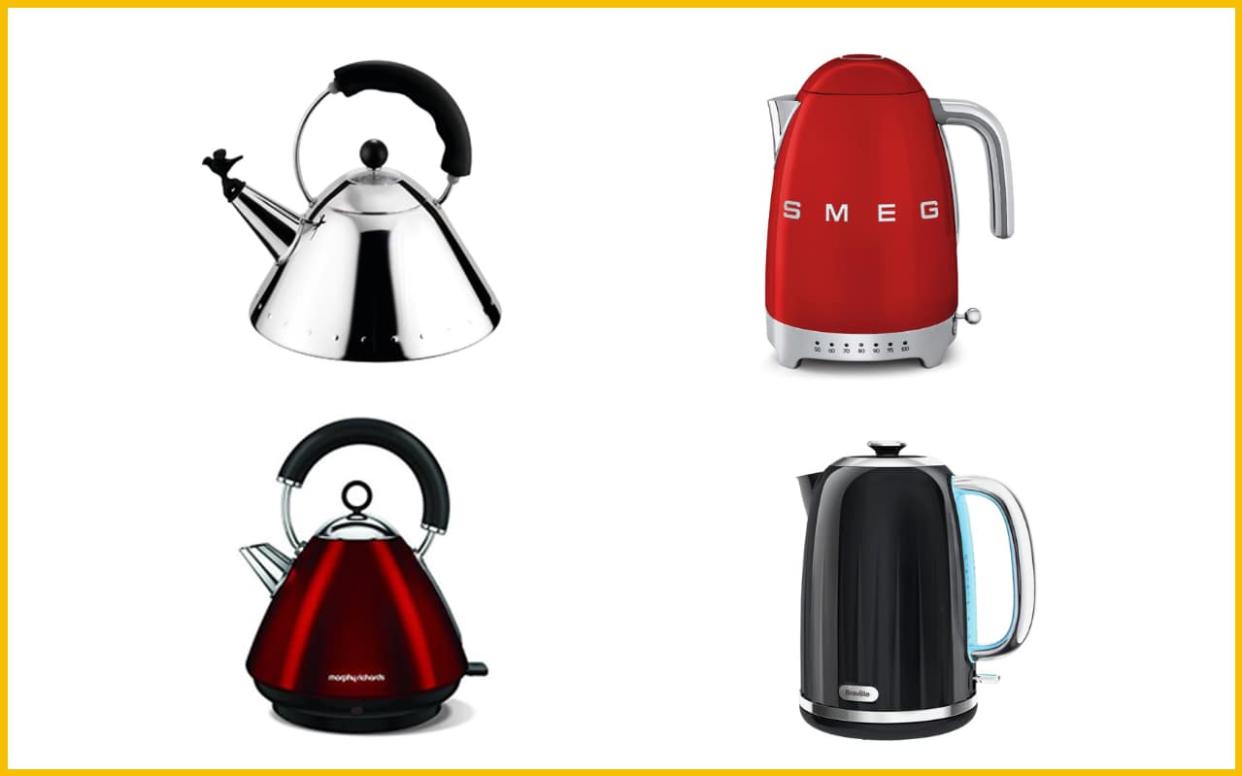
It's barely an exaggeration to say that the kettle is one of the most important tools in British life. We drink a whopping 165 million cups of tea, and 95 millions cups of coffee, every day. It's enough to make your forget that in many other countries, a kettle is a non-standard kitchen appliance. The poor souls.
Kettles broadly fall into two categories: electric and stovetop. Stovetop kettles are more traditional: you simply fill them up, place on the hob (most should work for all hob types) and wait for the whistle. It's a romantic, Instagram-friendly way to boil your water – but compared to an electric kettle, stovetop kettles take an age to boil. In my hunt for the best kettle out there, I decided to focus on electric models for that reason alone (interestingly, the energy efficiency of the two methods is roughly equal – as this in-depth article explains.)
The good news is that electric kettles are still very simple (basically a heating element in a container), which means you don't have to spend loads to buy a good one. During testing, I found the more expensive models, which have more features, tend to feel sturdier; but nonetheless, a £30 kettle should do the job just fine.
Because they're so simple, modern advances can seem a bit pointless. For example, there are smart kettles which allow you to control them from your phone. Having tested these before, I've found them to be largely pointless: boiling a kettle isn't exactly time consuming or rocket science, so the introduction of internet-connected technology just feels unnecessary. No smart kettles have been included in this review.
In my honest opinion, all you really need from an electric kettle is an on-off switch, a shut-off function (which means it'll turn off when ready), and a gauge indicating how many cups' worth of water is in the machine – this helps prevent waste.
I tested a variety of electric kettles over a wide price range. Though I found them to be fairly consistent in performance, things like speed and sound (some can be really noisy) were the biggest discrepancies.
All were boiled multiple times, with both a single cup of water and at full capacity.
1. Smeg KLF04 variable temperature kettle
Why we like it: Temperature control and smart retro looks
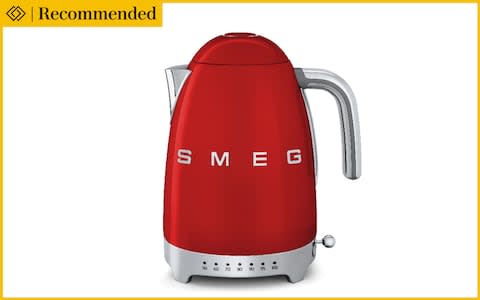
Okay, okay. I know north of £150 is a lot to splash on a kettle – too much, probably. As I just mentioned, you can shave off over £100 and still get something perfectly good. So, if you’d never consider spending this much on a kettle, that’s fine – just move down to the next one.
But if you would shell out the money, then I can't recommended the KLF04 enough. There are two reasons I thought it stood out. Firstly, it’s made by Smeg, and most kitchen products I’ve tried by the Italian brand have been excellent – no difference here. Secondly, it offers temperature control, something I didn’t come across with the other kettles I tested.
While this may sound like an unnecessary addition to a simple concept, for non-builder's-tea drinkers, it might mean a better brew. To make many hot drinks, you don’t want water at 100C as it can ruin the flavour. Coffee, for example, is best brewed at between 91C and 96C; delicate teas like 50C-60Cm and green or white tea 70C-80C. With this kettle, you can get that correct temperature easily. All you have to do is press a button at the bottom of the unit to select your desired heat.
There’s also a useful keep-warm facility maintaining the water’s temperature for 20 minutes – great if you forget you’ve put the kettle on.
The appliance itself is a looker, with a classy vintage design. Though substance over style in the kitchen is important, kettles are always on show, so having a nice-looking one can improve your kitchen aesthetics. It comes in various colours, but I quite liked the vivid red. Like all good kettles these days, you can see how close you are to the max (1.7 litre).
Boiling times were impressively quick. Water for a single cup boiled in under 30 seconds, and a full kettle just three-and-a-half minutes. It was one of the quietest, too (some kettles sound like a steam train). One slight bugbear, however, was the annoying beep when you switch it on – like someone is ringing the doorbell.
2. DELONGHI Avvolta KBA3001.W jug kettle
Why we like it: Water doesn't gush out from the spout
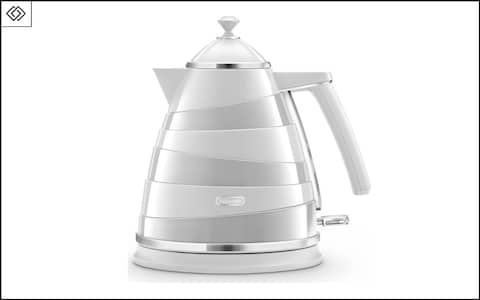
I know I said aesthetics shouldn’t be discarded when buying a kettle... but this kettle does look weird. It reminds me of poorly stacked bowls in a cupboard.
Anyway, if you can overcome that (or indeed if you like the wacky design), then this mid-price kettle is certainly worth a punt. Boiling temperatures were good: 45 seconds for a cup; three minutes and 25 seconds when full (1.7 litres). The lid is easily removable – some kettle lids are quite faffy, which can be annoying. The handle didn’t heat up at all, again unlike some others.
Though plasticky, it feels sturdy, and De’Longhi products are known to be durable.
The main reason I’ve elevated this appliance to such a high status, however, is a remarkably simple one, and one that most of the kettles I tried don’t seem to have mastered. When you pour boiling water from a kettle, you don’t want it to to gush out. This is both dangerous and bad for a drink’s flavour, especially coffee. The De’Longhi flowed quite slowly and thinly from the spout. Buonissimo!
3. Dualit Classic Kettle
Why we like it: A classic brand with unparalleled durability

Dualit are famous for their durable, best-in-class toasters, but their kettles are also excellent. I’ve had a Dualit kettle (not this model) for over a decade and it hasn’t shown any sign of letting up. They also benefit from smart, utilitarian looks. Like the toaster, the parts are repairable, so this could be your kettle for life.
The Dualit was the tallest kettle I tested. It's elegant and slim, with a long, comfortable handle that never got too hot. Full capacity is 1.7 litres – pretty much standard. A gauge indicates whether the kettle’s full, and signals how many cups of boiling water you’re preparing, which can help reduce waste.
The Classic was on the quieter end – or, more accurately, it was less loud than most. Its boiling time for one cup of water was 50 seconds, which is average; but when full it took just 2 minutes and 51 seconds, the best of the bunch. The spout ensures water doesn’t flow too quickly, another plus.
A top option, if on the pricier side, though it lacks some of the features of the Smeg.
4. Morphy Richards Pyramid Kettle Accents Red

A very nice kettle to look at, with a design based on old-school stove-top kettles. It’s basic – there’s simply an on-off switch and a gauge telling you how many cups’ worth you’ve got. For one cup of water it boiled at an impressive 30 seconds, and it took only two minutes and 30 seconds when full (1.5 litres, so not as big as some).
However, it sounded like an angry buffalo blowing hot air while doing so. I'm also not a fan of handles above (rather than on the side of) the main body of the kettle, as it feels a little cack-handed to pour, and your hands can get hot. Water flowed out of the spout rather quickly and voluminously, which isn't ideal.
A very affordable option that produces speedy results. There are reports online suggesting the colour can fade after a few months.
5. Breville Impressions VKJ755 jug kettle
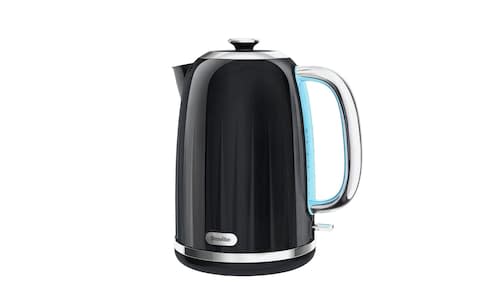
Pretty to look at, not too loud, and pleasingly simple: all there is is an on-off switch and a 'max' sign, enough for eight cups of tea. One cup of water boiled in 50 seconds, competitive with more expensive kettles. A full kettle boiled in three minutes, also not too bad.
All in, the kettle was absolutely fine on performance. However, almost immediately after first use it began to emit a slightly sulphurous smell. It didn't impact the flavour much, but it's still quite unappetising. This didn't improve much on further use.
Curious to learn more, I discovered that 'smelly kettle syndrome' is a recognised thing. According to Which?, it is caused by a combination of chemicals in tap water and in the kettle. While this isn't necessarily dangerous, it isn't enticing either.
It's worth noting that a vast majority of online reviews for this kettle don't notice the smell, so maybe I was unlucky. (I tested the kettle on the same day as others, with the same water, multiple times over.)
A Breville spokesperson said: "All Breville kettles are manufactured to the required British and EU regulations and guidelines with regards to material and process food contact safety. To seal the housing body a silicon ring is used in the base. These can sometimes emit a (similar) slight odour, affecting less than 0.1 pc of sales unites. There is no harm to the user as silicon material is of food contact safety grade."
Breville advise cleaning the kettle as per the instruction booklet, and "we would always look to support the customer to resolve their issue to their satisfaction on a case-by-case basis."
The best stove-top kettles
Stovetop kettles are far less convenient than electric ones, but they're easier to clean, more durable and have a romantic air to them. Waiting for the whistle to signify boiling water is always exciting.
Alessi 9093 B stainless steel kettle

You can't argue with the timeless design of this Alessi kettle. It reeks of Italian chic, although it was designed by esteemed American architect Michael Graves, way back in 1985. It draws on art deco and pop art influences, and the whistling bird is classic. The Rolls Royce of kettles.
The main benefit of a stovetop kettle like this, aside from looks, is durability – essentially, it will last for as long as you like. On the other hand, electric models are obviously liable to malfunctions.
The Alessi will work on most hob types – electric, gas, induction and an Aga. On my gas hob it made for somewhat loud boiling, though that was mostly the sound coming from the hob rather than the kettle.
Capacity is two litres, and I don't imagine there's a minimum as long as you've got enough water coverage. It took more than 10 minutes to boil when full (this was on a medium heat, and I had no easily accessible method of testing the hob's temperature; it will be less or more depending on your hob). One cup took almost four minutes. This is nowhere near as efficient as the electric ones, but the whistling bird made up for that.
Some report complaints about fitting the lid properly – I didn't find that. I did, however, notice the handle would heat up from the steam, so be careful when pouring (and you should also remove the bird). The spout is a good size for pouring.
Not a quick boiler necessarily, but it'll last a long, long time.
Stellar Casstel kettle

I'm very keen on the slanted twist on the classic kettle design. It feels more old-school than the Alessi, perhaps a bit less stylish and modern. There are many similarities – capacity, boil time, sound (it also whistles when done).
I did find, however, that water gushed out rather quickly and the handle became very hot to the touch, meaning I had to wait a minute or two before pouring.
But it's made of sturdy stainless steel, like the Alessi, and will last a lifetime (plus it's half the price).
Kettles FAQ
There are two main types of kettle: jug and traditional. Jug kettles are tall and slim – they look, well, like jugs, and are mostly electric. Traditional kettles are squatter and rounder (most stovetop kettles will look like this, but plenty of electric ones borrow from the classic aesthetic).
The good news is that kettles are pretty basic appliances – and you don't need to break the bank to buy something that can make you a mug of tea or cup of coffee.
The simplest is the stovetop kettle, which is essentially just a metal vessel that heats up water, with a lid, a handle, a spout and a whistle. There's not much tech to it, and they can last as long as the quality of the metal.
Electric kettles are a little more complex, but not much. When switched on, an electric current flows through a metal coil, which turns the energy into heat. That's pretty much all there is to it.
What features should I look out for?
While kettles remain pleasingly free of frills, there are some modern updates that are useful. The following information is for electric rather than stovetop kettles. I omitted smart kettles from testing after a bad experience with one (and to be honest, you shouldn't need a mobile phone to make a cuppa).
There are a few key features that all modern kettles, even the cheaper options, should have. An on-off switch kicks off the process, and it should automatically switch off once the boiling is complete. Some switches will illuminate when on.
Electric kettles usually have a protective mesh in the spout, called a limescale filter (all those tested do). This prevents grubby bits from infiltrating your drink.
You want your kettle to have a gauge showing you the minimum and maximum water levels (which helps ensure safety, keeps your kettle in good condition, and means you don't need to overfill, saving water and energy). Most kettles have a maximum capacity of 1.7 litres, around eight cups of tea.
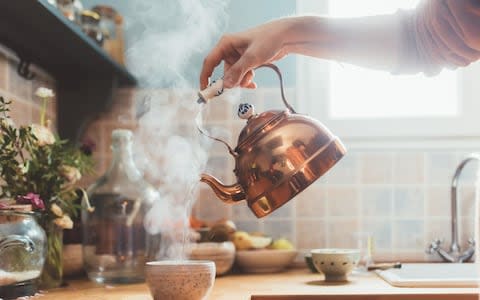
There may be a keep-warm function, on the pricier models, which ensures the water stays warm for a while after boiling. This is a nice function but ultimately unnecessary unless you're extremely forgetful or like to get ahead with your boiling (who does that?). According to Which?, a keep-warm function uses more energy than re-boiling, so it's actually rather pointless – boiling the amount you want is most efficient.
One feature I did like is the multiple temperature setting, which allows you to set the temperature you want. This is useful for things like coffee (best at around 95C), and green tea (between 70C and 80C is ideal). Only the pricier models tend to offer this.
While this may sound a tad finicky – can the average Joe or Josephine really tell the difference? – according to Mike Logue, Head of Operations at Caravan Coffee Roasters, the right temperature is paramount for a good mug of Java.
"If the water is too hot, straight off the boil, you will scald the coffee, which will affect the taste and aroma," Logue explains. "There are some great kettles on the market with temperature control." For black tea, 100C water is fine, so temperature control is less crucial.
You should also look at the size of the spout when getting a kettle, mostly for safety reasons. I've found when the spout is too big, water can gush out quite unpredictably, and your cup can easily overflow. Apparently thinner spouts (such as found on a gooseneck kettle), can also provide better results, especially for coffee.
What is limescale, why is there so much in my kettle, and how do I get rid of it?
We don't all have the same water. Across the country, the H2O in our taps varies between hard and soft. In the east and southeast of the country, it tends to be harder, while the west and north get soft water.
"Hard water is found in areas where there's chalk and limestone in the ground," explains Dr Emma Goslan, a lecturer in water chemistry at Cranfield University. "As it passes through the rocks, it picks up the chalk carbonates, and that determines the level of hardness."
In these chalky, limestone areas, therefore, the residues build up in the kettle and create a white scum. It will also create a slight film on tea or coffee, which is visible to the eye. "Hard water makes coffee taste more bitter, with a woodier taste," Goslan explains. Soft water is also said to be better for the flavour of tea.
There are no health disadvantages in hard water, according to Goslan. In fact, hard water has plenty of calcium, so it could even provide health benefits.
Goslan advises against using water softeners for boiling your water, because in the softening process the calcium is changed into sodium. Certain filters, like Brita, can soften your water, but many just remove chlorine and organic compounds, so it's worth checking the product information before buying.
There are a few ways to prevent limescale (a common one is a kettle descaler, which is a wiry stainless steel ball placed in the device that attracts the residue). But whether your water is soft or hard, at some point you will get a build up of limescale. Goslan's favoured method of removal is simple: "The best way is to add some vinegar and water and leave it to soak, it doesn't matter if it's hot or cold water."
The 'smelly kettle' controversy
In 2015, many kettle users began to notice a foul sulphurous smell coming from their kettles, which affected the drink's flavour as well. This has affected a range of kettles over several brands, from expensive to cheap. It happened when I tested the Breville, which was the first time I'd encountered the issue.
While there doesn't appear to be a definitive answer on why this happens, it could be to do with a reaction between the chemicals in the water and the chemicals in the device. If you notice it in your kettle, contact the manufacturer.


 Yahoo News
Yahoo News 
